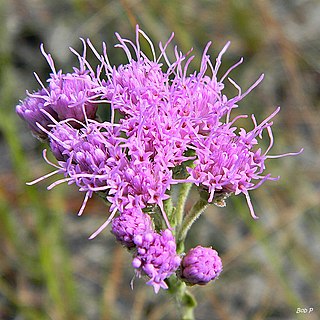
Boltonia diffusa, the smallhead doll's daisy, is a North American species of plants in the family Asteraceae. It native to the United States, primarily the states along the Gulf of Mexico from Texas to Florida plus the lower Mississippi Valley from Louisiana to Illinois. There additional populations in the eastern United States as far north as Virginia.

Chrysopsis, are plants in the family Asteraceae native to the southern and eastern United States. All the species are found in Florida, although some are found in other states as well.

Heterotheca, are North American plants in the family Asteraceae.

Heterotheca sessiliflora is a species of flowering plant in the family Asteraceae known by the common name sessileflower false goldenaster. It is native to California, Sonora, and Baja California.

Carphephorus is a genus of North American plants in the family Asteraceae. They are native to the southeastern United States from Louisiana to Virginia. Plants of this genus are known commonly as chaffheads.
Chrysopsis delaneyi, or DeLaney's goldenaster, is one of the endemic species to the U.S. state of Florida, recently discovered in the genus Chrysopsis, a small group of herbaceous plants of the family Asteraceae, known commonly as the "golden asters" and primarily native and restricted to Florida.

Chrysopsis mariana, known as the Maryland golden-aster, is a North American species of plants in the family Asteraceae. The Maryland golden-aster ranges from Rhode Island and New York, west to Kentucky and southern Ohio, and south as far as Florida and Texas.
Brintonia is a monotypic genus of flowering plants in the sunflower family, containing the single species Brintonia discoidea, named for Jeremiah Bernard Brinton. It is known commonly as the rayless mock goldenrod. It is native to the southeastern United States, where it is distributed in Alabama, Florida, Georgia, Louisiana, and Mississippi.

Symphyotrichum georgianum is a rare species of flowering plant in the Asteraceae, the aster family. Its common name is Georgia aster. It is native to the southeastern United States where it is known from Alabama, Florida, Georgia, North Carolina, and South Carolina. As of 2013, it may be extirpated from the state of Florida.

Bradburia pilosa, the soft goldenaster, is a North American species of flowering plants in the family Asteraceae, native to the south-central United States, primarily the southeastern Great Plains and lower Mississippi Valley, in the states of Texas, Oklahoma, Kansas, Missouri, Arkansas, Louisiana, Tennessee, Mississippi, and Alabama. Additional populations are reported farther east but these appear to be introductions.
Chrysopsis godfreyi, or Godfrey's goldenaster, is a North American species of flowering plant in the family Asteraceae. It is native to the states of Florida and Alabama in the southeastern United States.

Chrysopsis scabrella, called the Coastalplain goldenaster, is a North American species of flowering plant in the family Asteraceae. It is native primarily to Florida with a few isolated populations in North and South Carolina.
Chrysopsis lanuginosa, called the Lynn Haven goldenaster, is a North American species of flowering plant in the family Asteraceae. It has been found only in the Florida Panhandle.
Chrysopsis subulata, called the scrubland goldenaster, is a North American species of flowering plant in the family Asteraceae. It has been found only in Florida.
Chrysopsis linearifolia, the narrowleaf goldenaster, is a North American species of flowering plant in the family Asteraceae. It has been found only in Florida.
Chrysopsis latisquamea, the pineland goldenaster, is a North American species of flowering plant in the family Asteraceae. It has been found only in Florida.

Helianthus atrorubens is a North American species of sunflower known by the common name purpledisc sunflower. It is native to the southeastern United States. It is found in all the coastal states from Louisiana to Virginia, plus the inland states of Kentucky and Tennessee.
Helianthus floridanus is a species of sunflower known by the common name Florida sunflower. It is native to the southeastern United States, found in all the coastal states from Alabama to North Carolina, plus Louisiana.

Heterotheca camporum, known by the common name lemonyellow false goldenaster, is a North American species of flowering plant in the family Asteraceae. It is found only in the central United States, primarily the Ozarks, the Cumberland Plateau, and the middle Mississippi Valley. There are reports of additional populations in the Northeast, the Southeast, and in the Great Lakes region, but these appear to be waifs or naturalizations.

Symphyotrichum elliottii is a species of flowering plant in the family Asteraceae native to the southeastern United States Atlantic coastal plain where it grows in wetland areas. Commonly known as Elliott's aster, it is a perennial, herbaceous plant that may reach 6 to 20 decimeters tall. Its flowers have pink ray florets and pale yellow, then pink, then brown disk florets. NatureServe, as of July 2021, classified S. elliottii as Apparently Secure (G4) globally, and of conservation concern in North Carolina, South Carolina, and Virginia.












